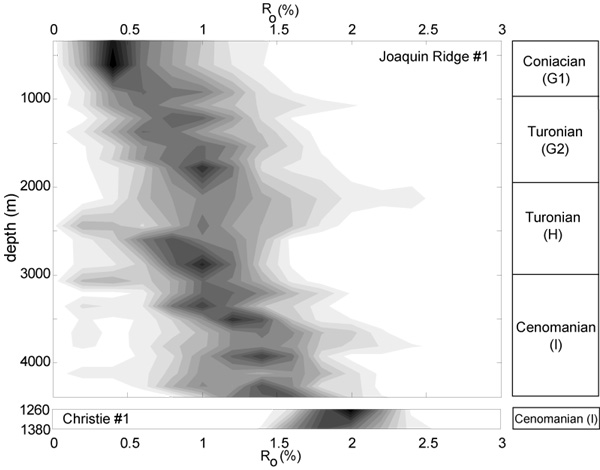
|

|
Additional evidence for a heating event comes from vitrinite
reflectance data from two wells on Joaquin Ridge (see
Figure 1 for the location of the wells, and
Figure 4 for the vitrinite reflectance data). The
``Joaquin Ridge #1'' well is 4,390 m deep and located in the vicinity
of sample JR3. The ``Christie #1'' well is 1,380 m deep, and located
next to sample JR2. Micro-paleontological ages have been obtained for
both wells (Martin B. Lagoe, written communication). ``Joaquin Ridge
#1'' sediments are of Coniacian (at 910 m) to Cenomanian age (at TD),
whereas the ``Christie #1'' samples at TD are Cenomanian (Figure
4). Twenty-three samples from the ``Joaquin Ridge
#1'' well were analyzed, from depths of 300 to 4,390 m. They show
![]() values of 0.6-1.5%, explaining why apatite fission track
samples JR3, JR4, and JR5 have not been thermally reset. These
samples are all located upsection from the shallowest ``Joaquin Ridge
#1'' vitrinite reflectance samples and should, therefore, correspond
to
values of 0.6-1.5%, explaining why apatite fission track
samples JR3, JR4, and JR5 have not been thermally reset. These
samples are all located upsection from the shallowest ``Joaquin Ridge
#1'' vitrinite reflectance samples and should, therefore, correspond
to ![]() values
values ![]() 0.6%, or maximum paleo-temperatures less than
0.6%, or maximum paleo-temperatures less than
![]() 85
85![]() (Sweeney and Burnham, 1990). The ``Joaquin Ridge #1''
vitrinite reflectance data imply a thermal gradient of
(Sweeney and Burnham, 1990). The ``Joaquin Ridge #1''
vitrinite reflectance data imply a thermal gradient of ![]() 14
14
![]() C/km, which was normal in the Great Valley forearc basin (Dumitru,
1988). There exists substantial evidence that the geothermal gradient
in the Great Valley Group was very low during the Cretaceous and the
beginning of the Tertiary. This is postulated to have been caused by
the refrigerating effect of the subducting Farallon pLate (Dumitru,
1988). The ``Christie #1'' well is located near sample JR2. Three
cores taken in ``Christie #1'' at 1,250-1,380 m are characterized by
vitrinite reflectance values of
C/km, which was normal in the Great Valley forearc basin (Dumitru,
1988). There exists substantial evidence that the geothermal gradient
in the Great Valley Group was very low during the Cretaceous and the
beginning of the Tertiary. This is postulated to have been caused by
the refrigerating effect of the subducting Farallon pLate (Dumitru,
1988). The ``Christie #1'' well is located near sample JR2. Three
cores taken in ``Christie #1'' at 1,250-1,380 m are characterized by
vitrinite reflectance values of ![]() 1.9-2.0%, or maximum
paleotemperatures of
1.9-2.0%, or maximum
paleotemperatures of ![]() 180
180![]() , very hot for the Great Valley
Group. However, apatite fission track sample JR2, located about
1,500-2,000 m upsection from the ``Christie #1'' vitrinite
reflectance samples, has not been reset. Assuming a thermal gradient
similar to that inferred from the ``Joaquin Ridge #1'' well, this
would lower the predicted vitrinite reflectance value for sample JR2
to about
, very hot for the Great Valley
Group. However, apatite fission track sample JR2, located about
1,500-2,000 m upsection from the ``Christie #1'' vitrinite
reflectance samples, has not been reset. Assuming a thermal gradient
similar to that inferred from the ``Joaquin Ridge #1'' well, this
would lower the predicted vitrinite reflectance value for sample JR2
to about ![]() = 1.3% (maximum paleo-temperature
= 1.3% (maximum paleo-temperature ![]() 150
150![]() ).
This rough estimate, if correct, conflicts with the observation that
apatite fission track sample JR2 has not been completely annealed.
This would imply that the high
).
This rough estimate, if correct, conflicts with the observation that
apatite fission track sample JR2 has not been completely annealed.
This would imply that the high ![]() values of ``Christie #1'' are
due to a thermal anomaly, that the thermal gradient in this well was
not equal to that of ``Joaquin Ridge #1'', and/or that this gradient
was not linear. Although not reset, sample JR2 has been at
paleo-temperatures above those of samples JR3, JR4, and JR5. The high
paleo-temperatures of the ``Christie #1'' samples are unlikely to be
the result of simple burial, but are instead interpreted to be the
result of a Middle Miocene heating spike, associated with the upward
protrusion and tectonic denudation of the New Idria serpentinite body.
values of ``Christie #1'' are
due to a thermal anomaly, that the thermal gradient in this well was
not equal to that of ``Joaquin Ridge #1'', and/or that this gradient
was not linear. Although not reset, sample JR2 has been at
paleo-temperatures above those of samples JR3, JR4, and JR5. The high
paleo-temperatures of the ``Christie #1'' samples are unlikely to be
the result of simple burial, but are instead interpreted to be the
result of a Middle Miocene heating spike, associated with the upward
protrusion and tectonic denudation of the New Idria serpentinite body.